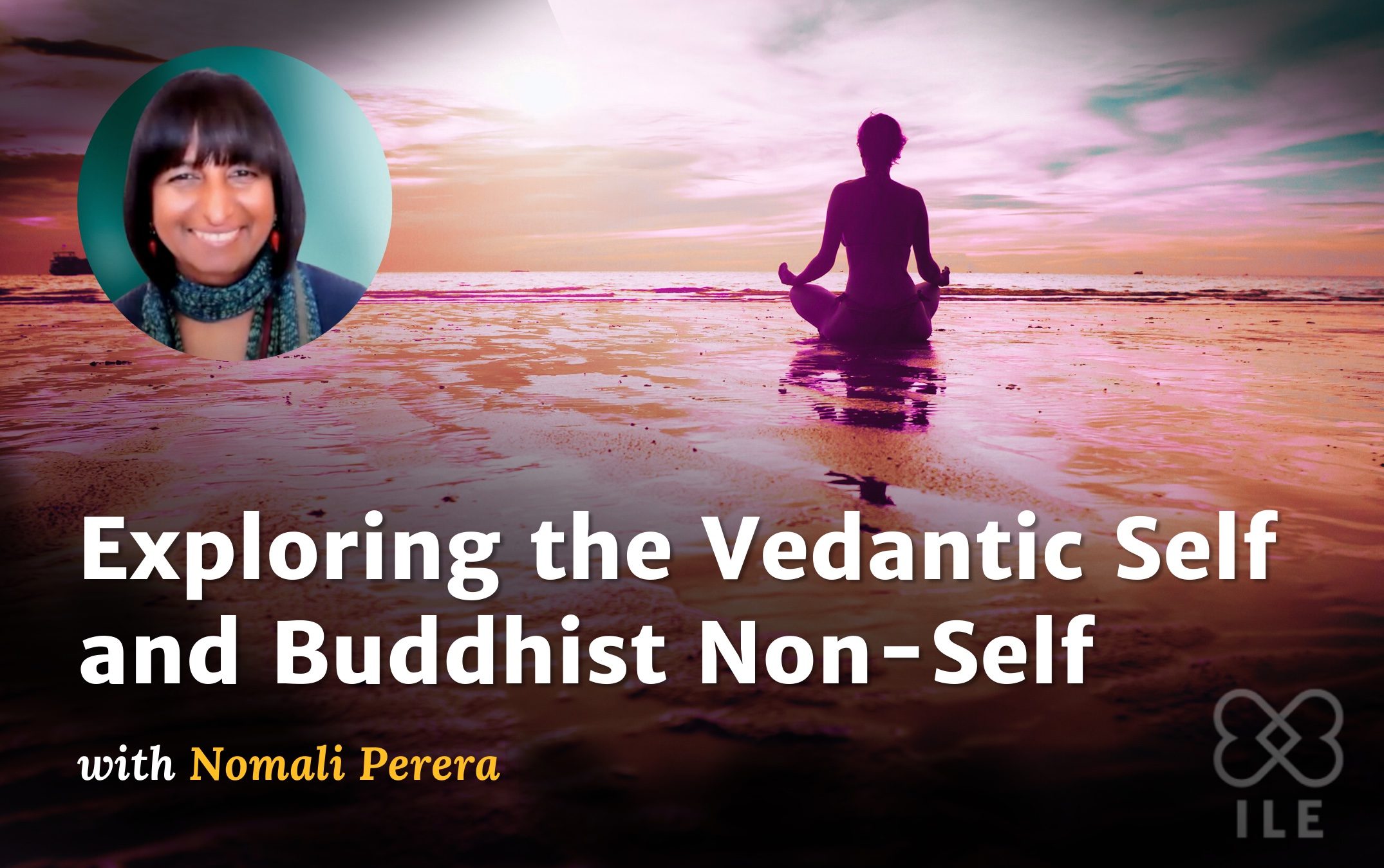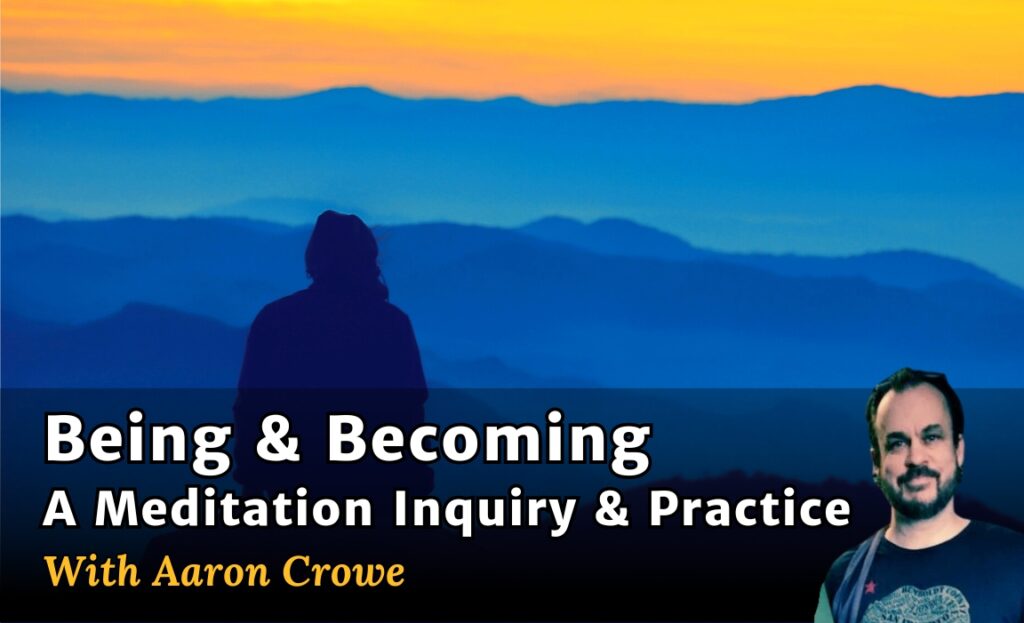
- This practice session has passed.
Eastern Philosophy: Exploring the Vedantic Self and Buddhist Non-Self

This event starts in:
This Integral Life Experience is only available to the supporting members
Whether it is the individual and collective, the inner and outer, east and west or evolution and involution, Integralists love to integrate! That’s why at this session we will look into two age-old views that come from eastern philosophical thought: the Vedantic concept of Self and the Buddhist concept of Non-self. In the meantime, how do you experience your own sense of self? Who are you, really?
Please watch this video prior to the session:
Vedantic Self and Buddhist Non-Self | Swami Sarvapriyananda
Scroll down this page to find some terms and concepts you will hear in this discourse in the order in which they were mentioned.*
For those of you in the John Vervaeke Study Group, you will be pleasantly surprised to encounter various western philosophical concepts we have studied with Vervaeke being described as they emerged in the east around the Axial Age. In this video is also a good depiction of making philosophical arguments that seek to integrate differing views.
Other optional resources:
- Vedanta and Buddhism essay
- Video especially good for those who are new to this topic: Advaita Vedanta and Buddhism: Andrew Holecek in conversation with Swami Sarvapriyananda
- Another Kind of Self-Inquiry: Chandrakirti’s Sevenfold Reasoning on Selflessness (click on the 7th bullet to scroll down)
- Colorful Nothing: Emptiness in the Madhyamaka, by Jimmy Pianka (12-page PDF)
- The Concept of Soul or Self in Vedanta, by Swami Tathagatananda
- The Sun of Wisdom: Teachings on the Noble Nagarjuna’s Fundamental Wisdom of the Middle Way (book)
- I Am That: Talks with Sri Nisargadatta Maharaj (book)
Optional: Join 10 minutes early to chit-chat, meditate or engage in some music together.
* Some terms and concepts you will hear in this discourse in the order in which they are mentioned:
- The inquiry in this discussion is the relationship of the everyday body-mind (individual, relative, small s self) to Atma (Immortal, Absolute, Big S Self). It is viewed specifically in how the Buddhist teacher Chandrakirti argued the Hindu Vendantic concept of the Immortal Self, followed by the Advaita Vedantic response.
- Vesak or Vaishak, the Thrice Blessed Day in Buddhist countries is the day in which the Gautama Buddha’s birth, enlightenment and passing is commemorated. It is typically celebrated on the day of the full moon in the month of May.
- Atman – Self (generally from Hinduism)
- Anatman/Anatta – No-self (generally from Buddhism)
- Six Orthodox Schools of Hindu Philosophy: Nyaya, Sankhya, Yoga, Vaisheshika, Purva Mimamsa, Uttara Mimamsa (Vedanta) Learn more here – https://byjus.com/free-ias-prep/6-orthodox-schools-hindu-philosophy/
- Advaita Master: Shankara / Adi Shankaracharya
- Tibetan masters – Je Tsongkhapa 1419 CE (Gelugpa school, Dalai Lama’s lineage)
- Main schools of Tibetan Buddhism – https://www.tibettravel.org/tibetan-buddhism/schools-of-tibetan-buddhism.html
- Jivatma: the individual, relative, small s self or soul, the many
- Paramatma: the Immortal, Supreme, Absolute, Big S Self or Soul, The One (Atma is same – “Ātmā may be described as God’s ray of light, which exists as the “light of life” in every living being. It is part of Paramātmā and is therefore identical in nature with it. Just as the seed of a tree contains all the qualities of the tree, the Ātmā also contains the qualities of the Supreme Self. – The Upanishad)
- Mukti – moksha – freedom (jeevamukti)
- Dualists schools – Dvaitans
- Non-dualists schools – Advaitans
- The Four Noble Truths
There is suffering/dukka/disatisfaction (in obvious and subtle forms)
There is a cause of suffering (craving/thrishna/tanha)
There can be an end to suffering (by awakening/Nirvana/Moksha)
There is a path to end suffering (the 8-fold path/Ashtanga Marga) - Buddhist philosophers and teachers after the Buddha’s time: Nagarjuna, Dharmakirti, Chandrakirti
- Nagarjuna (considered as the greatest teacher of Mahayana Buddhism) wrote the Mulamadhamakarika (“the teachings of the Middle Way on the doctrine of ultimate “emptiness.” which leads us to the “Perfection of Wisdom”/Prajnaparamita)
- The Middle Way: the path of wisdom between the two extremes of eternalism (eternal truth) and nihilism (no truth)
- Emptiness = Shunyata
- Thathagata = Buddha
- Chatuskoti = Nagarjuna’s Four Negations or Four Alternative Logical Arguments
1. X is not real
2. X is not unreal (or X is not not-real)
3. X is both real and unreal
4. X is neither real nor unreal
1) The self is not real
2) The self is not unreal
3) The self is both real and unreal
4) The self is neither real nor unreal
- Chatuskoti vinirmukto tatwam = Ultimately, reality is beyond the four alternatives – Reality is empty.
- Shunyata sarvadushti nam = emptiness of all views
- Three kinds of debate in ancient India:
Vada – an honest debate with intention to find the truth
Jalpa – cut down each others’ propositions
Vitanda – “I have no view, but I will cut down your view.” There is no counter-thesis (or antithesis). - Chandrakirti (600 CE) introduced the Sevenfold Reasoning on the perception of self. He argued that there is no independent, immortal self.
- The Five Skandhas (or the Five Aggregates) make up the body-mind. Skandhas are temporary, conditioned phenomena empty of a soul or permanent essence of self.
Rupa-skandha – aggregate of form
Vedana-skandha – aggregate of sensations/feelings
Samjña-skandha – aggregate of metal-cognitive perceptions/recognition, labels or ideas (recognize a sound from a shape, for example)
Samskara-skandha – aggregate of mental-volitional formations (desires, wishes and tendencies)
Vijñana-skandha – aggregate of consciousness through seeing, hearing, smelling, tasting, touching, mind-mental - The Five Koshas/Bodies/Sheaths (easy to grasp article – https://yogainternational.com/article/view/the-koshas-5-layers-of-being)
Annamaya Kosha (Physical Sheath) – physical body
Pranamaya Kosha (Vital Energy Sheath) – subtle body
Manomaya Kosha (Mental Body) – subtle body
Vijnanamaya Kosha (Wisdom or Awareness Body) – subtle body
Anandamaya Kosha (Bliss Body) – Most subtle body - Chandrakirti uses the metaphor of a Chariot and its parts to make his sevenfold argument.
What is the relationship of the chariot to its parts? Where does the chariot begin or end? What is chariot-ness? What is the relationship of the Self/Atma to its body-mind? Where does the Self/Atma begin or end? - Hindus would say there is a trichotomous personality: Physical Body, Subtle Body and the Atma.
Chandrakirti then presents 7 ways in which one can speak of a Self/Atma and he refutes them.
The Chariot is the same as its parts
The Chariot is something apart from its parts
The Chariot is something that is contained in the parts
The Chariot is something that contains the parts (the parts are contained the Chariot)
The Chariot is something that possesses its parts
The Chariot is a *collection* of its parts
The Chariot is just a shape that emerges from the way the parts are configured. - The Advaita Response : We are not saying that the Atma/Self is in body-mind nor that the Atma/Self is separate from the body-mind. We agree with Chandrakirti in this. We are saying that you are not the body-mind, and to demonstrate that, we show that you are the witness of the body-mind but we don’t want to say that there is a separate witness of body-mind. That is not Advaita. We do this in order to cut at the root at identification with body-mind. We have a tendency to cling to the body-mind. And we insist that you cannot be the body-mind. – Swami Sarvapriyananda
- So what is it that you want to say to establish the Atma/Self?
The Golden Ornaments metaphor:
1. Is gold the same as the necklace?
2. Is the gold apart from the necklace?
3. Is there gold contained inside the jewelry?
4. Is gold something that contains the jewelry?
5. Is gold the possessor of a necklace?
6. Is gold the collection of the jewelry?
7. Is gold the shape of a piece of jewelry? - These two traditions are extremely similar. One states the truth negatively and the other positively.
- The dangers of the path via-negativa (Buddhism) is it can seem nihilist. Nothing exists.
The dangers of the path via-positiva makes you look like an eternalist. Nothing ends. - Emptiness = Fullness (Shunyam = Poornam)
- Ultimately it is NO-THING (inexhaustible no-thing-ness Emptiness
- Progressive Stages of Meditation on Emptiness, by Venerable Khenpo Tsultrim Gyamtso Rinpoche
Theravada or Sravaka Meditation on Not Self – emptiness of the self (anatta)
Mind only school – There is no change outside or inside – it is all in the mind only. there is no change and no universe (cittamatra school). The world simply appears in the mind.
There is no mind either! Svatantrika Madhymaka school You cannot say anything as it can be refuted but the Four Negations (Nagarjuna). The world is empty, the self is empty.
Emptiness is also empty. – Prasangika Madhyamika school / Tibet
Mahamadhyamika / Shentong / Mahamudra – Where does anything at all arise? All of samsara and nirvana appear together in basic space of awareness (“clear light”). Reality is a vast, unlimited space of awareness. Pure awareness. No beginning – no ending – Nonduality – Buddha nature / Brahman. At this last stage, buddhist no-self and advaita self come together! - Sri Ramakrishna quotes
When you know yourself you know God.
“What do you mean by knowing yourself? Where is this I in this body-mind? Where is it? As you inquire into the body and mind, you will find there is nothing corresponding to the I – It is empty. What remains is consciousness.” - It could be said that the Buddha didn’t accept an ultimate reality, which has meant that he’s been called an atheist. But Ramakrishna says it isn’t that the Buddha wasn’t an atheist. It is simply that the Buddha didn’t have words to express what he found. Where it is between IS (eternalism) and IS NOT (nihilism) is the middle path where truth lives.
It could also be said that it isn’t that the Buddha didn’t have the words, but rather that the Buddha chose not to express the inexpressible with words.
This is where the two meet in harmony!
Meet Your Practice Leader
Nomali Perera, MA, PCC, has been in the field of leadership development coaching, facilitation and teaching since 2007. Nomali is a trained facilitator of the Immunity to Change™ process, a Master Coach at Life XT and a certified Integral Master Coach through Integral Coaching Canada. Nomali has also been a professional consultant in people development and training in Brazil and Mexico. She currently lives in Boulder, Colorado.



